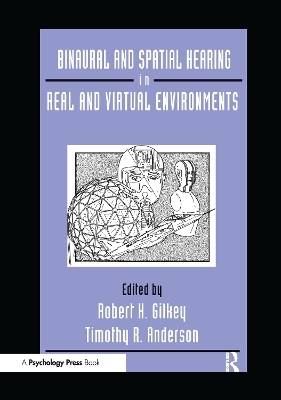
Binaural and Spatial Hearing in Real and Virtual Environments
Psychology Press (Verlag)
978-0-8058-1654-9 (ISBN)
The current popular and scientific interest in virtual environments has provided a new impetus for investigating binaural and spatial hearing. However, the many intriguing phenomena of spatial hearing have long made it an exciting area of scientific inquiry. Psychophysical and physiological investigations of spatial hearing seem to be converging on common explanations of underlying mechanisms. These understandings have in turn been incorporated into sophisticated yet mathematically tractable models of binaural interaction. Thus, binaural and spatial hearing is one of the few areas in which professionals are soon likely to find adequate physiological explanations of complex psychological phenomena that can be reasonably and usefully approximated by mathematical and physical models.
This volume grew out of the Conference on Binaural and Spatial Hearing, a four-day event held at Wright-Patterson Air Force Base in response to rapid developments in binaural and spatial hearing research and technology. Meant to be more than just a proceedings, it presents chapters that are longer than typical proceedings papers and contain considerably more review material, including extensive bibliographies in many cases.
Arranged into topical sections, the chapters represent major thrusts in the recent literature. The authors of the first chapter in each section have been encouraged to take a broad perspective and review the current state of literature. Subsequent chapters in each section tend to be somewhat more narrowly focused, and often emphasize the authors' own work. Thus, each section provides overview, background, and current research on a particular topic. This book is significant in that it reviews the important work during the past 10 to 15 years, and provides greater breadth and depth than most of the previous works.
Robert Gilkey, Timothy R. Anderson
Contents: Part I:Sound Localization.F.L. Wightman, D.J. Kistler, Factors Affecting the Relative Salience of Sound Localization Cues. E.A.G. Shaw, Acoustical Features of the Human External Ear. R.O. Duda, Elevation Dependence of the Interaural Transfer Function. J.C. Middlebrooks, Spectral Shape Cues for Sound Localization. R.A. Butler, Spatial Referents of Stimulus Frequencies: Their Role in Sound Localization. Part II:Lateralization and Binaural Masking.L.R. Bernstein, Detection and Discrimination of Interaural Disparities: Modern Earphone-based Studies. T.N. Buell, C. Trahiotis, Recent Experiments Concerning the Relative Potency and Interaction of Interaural Disparities. R.H. Dye, Jr., The Relative Contributions of Targets and Distractors in Judgments of Laterality Based on Interaural Differences of Level. A. Kohlrausch, R. Fassel, Binaural Masking Level Differences in Nonsimultaneous Masking. Part III:Echoes, Precedence, and Depth.W.M. Hartmann, Listening in a Room and the Precedence Effect. E.R. Hafter, Binaural Adaptation and the Effectiveness of a Stimulus Beyond Its Onset. R.K. Clifton, R.L. Freyman, The Precedence Effect: Beyond Echo Suppression. D.H. Mershon, Phenomenal Geometry and the Measurement of Perceived Auditory Distance. Part IV:Motion Perception.D.R. Perrott, T.Z. Strybel, Some Observations Regarding Motion-Without-Direction. D.W. Grantham, Auditory Motion Perception: Snapshots Re-visited. K. Saberi, E.R. Hafter, Experiments on Auditory Motion Discrimination. Part V:Sound Source Segregation and Free-Field Masking.W.A. Yost, The Cocktail Party Problem: Forty Years Later. M.D. Good, R.H. Gilkey, J.M. Ball, The Relation Between Detection in Noise and Localization in Noise in the Free Field. T.J. Doll, T.E. Hanna, Directional Cuing Effects in Auditory Recognition. Part VI:Physiology of Spatial Hearing.S. Kuwada, R. Batra, D.C. Fitzpatrick, Neural Processing of Binaural Temporal Cues. T.C.T. Yin, P.X. Joris, P.H. Smith, J.C.K. Chan, Neuronal Processing for Coding Interaural Time Disparities. J.F. Brugge, R.A. Reale, J.E. Hind, Auditory Cortex and Spatial Hearing. E.D. Young, J.J. Rice, G.A. Spirou, I. Nelken, R.A. Conley, Head-related Transfer Functions in Cat: Neural Representation and the Effects of Pinna Movement. Part VII:Models of Spatial Hearing.R.M. Stern, C. Trahiotis, Models of Binaural Perception. H.S. Colburn, S.K. Isabelle, D.J. Tollin, Modeling Binaural Detection Performance for Individual Masker Waveforms. J.A. Janko, T.R. Anderson, R.H. Gilkey, Using Neural Networks to Evaluate the Viability of Monaural and Interaural Cues for Sound Localization. Part VIII:Development of Spatial Hearing.R.Y. Litovsky, D.H. Ashmead, Development of Binaural and Spatial Hearing in Infants and Children. Part IX:Applications.J. Blauert, An Introduction to Binaural Technology. B. Shinn-Cunningham, H. Lehnert, G. Kramer, E. Wenzel, N. Durlach, Auditory Displays. M.D. Burkhard, Binaural Measurements and Applications. R.L. McKinley, M.A. Ericson, Flight Demonstration of a 3-D Auditory Display. M.A. Ericson, R.L. McKinley, The Intelligibility of Multiple Talkers Separated Spatially in Noise. J. Koehnke, J. Besing, Binaural Performance in Listeners with Impaired Hearing: Aided and Unaided Results. B. Kollmeier, Signal Processing for Hearing Aids Employing Binaural Cues.
| Erscheint lt. Verlag | 12.2.1997 |
|---|---|
| Verlagsort | Philadelphia |
| Sprache | englisch |
| Maße | 174 x 246 mm |
| Gewicht | 1587 g |
| Themenwelt | Informatik ► Grafik / Design ► Digitale Bildverarbeitung |
| Studium ► 1. Studienabschnitt (Vorklinik) ► Histologie / Embryologie | |
| Naturwissenschaften ► Biologie ► Humanbiologie | |
| Naturwissenschaften ► Biologie ► Zoologie | |
| Naturwissenschaften ► Physik / Astronomie ► Mechanik | |
| ISBN-10 | 0-8058-1654-2 / 0805816542 |
| ISBN-13 | 978-0-8058-1654-9 / 9780805816549 |
| Zustand | Neuware |
| Haben Sie eine Frage zum Produkt? |
aus dem Bereich


